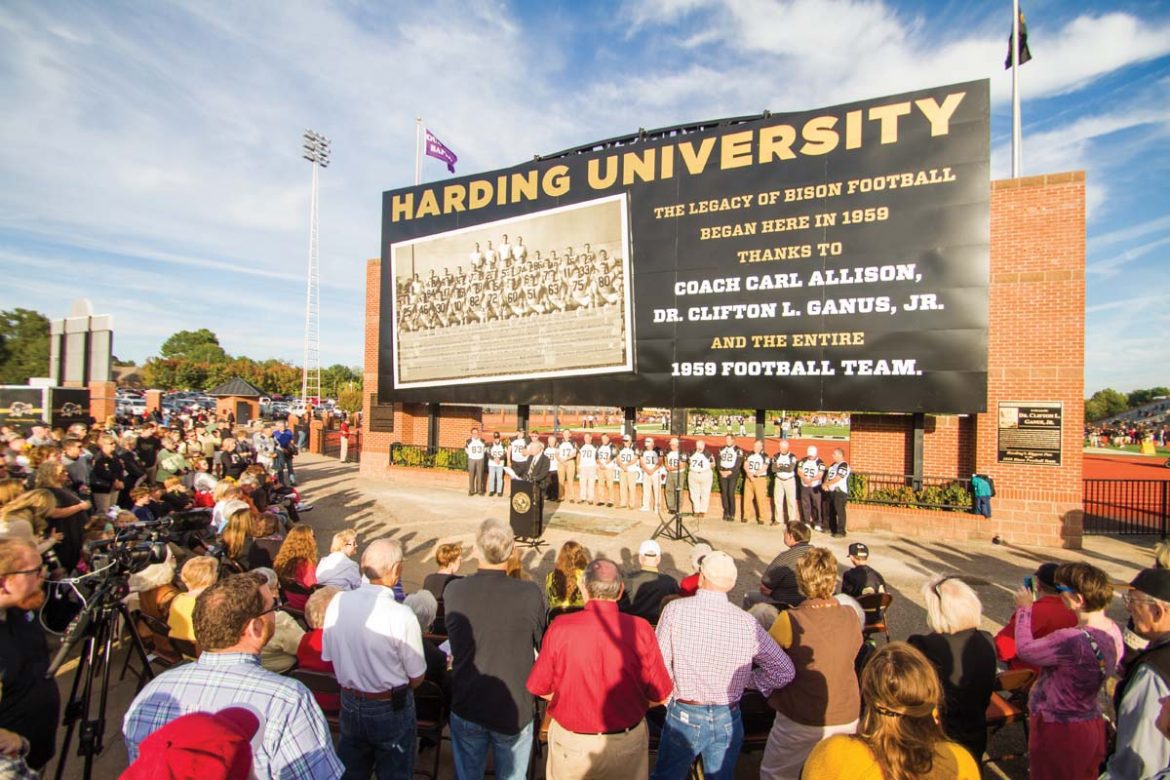When it opened its doors in 1924, Harding University fielded a football team. For seven years they played, but in 1931, due to budget restrictions, athletics as a whole were cut in order to save money.
For 28 years, Harding did not field a team. That was, until then-vice president and current chancellor emeritus Clifton L. Ganus proposed reinstating football to President George S. Benson, and Harding ultimately got the go-ahead to restart the program. While resuming play was one thing, assembling a semi-competitive team on the field was another entirely. The challenge quickly went from getting football back, to putting a team together.
“I didn’t know anything about Harding,” Dr. Billy Joe Thrasher, an offensive guard, nose tackle and co-captain on that first team said. “I came up from Florida junior college, but was approached at a tiny little camp by a real important looking man, and I’ll never forget it, he said, ‘Are you Billy Joe Thrasher? I’m Clifton Ganus, and I hear you can play some football.’ I went and it changed my life.”
One of the major selling points for the young and inexperienced Bisons football program was the man who was brought on to lead the team into the future in the spring of 1959: former captain of the Oklahoma Sooners, Carl Allison.
“In high school (Coach Allison) was my hero,” Lathan Garnett, a lineman and placekicker on the ’59 team said. “I got to see the games he actually played in at Oklahoma. He played both ways, was captain, and they never lost.”
Allison, at age 26, was fresh and coming off of a football career of his own during the golden years of Oklahoma football. He was part of a team that won 47 consecutive games and two national titles — an easy salesman to high school boys looking to continue their football careers.
“(Being asked to play football) was how I got to Harding,” Garnett said. “I was invited to come play and I didn’t even know where Searcy was.”
Jerry Mote, a sophomore cornerback and halfback at the time and now Harding football’s radio color commentator, arrived at Harding by way of football as well.
“My high school coach knew coach Allison well,” Mote said. “Coach Allison really wanted me to come and it was the best thing I ever did.”
Allison quickly began developing Harding’s football program. Using his knowledge of both sides of the ball from his playing days at Oklahoma, Allison’s dedication and work ethic began to have an effect on the team.
“He was so intense and such a competitor,” Mote said. “Everything he ever did, he threw himself into it, and that rubbed off on everyone around him. He had incredible enthusiasm and was very knowledgeable. Playing both ways at Oklahoma was a great asset to teach both sides of the ball.”
Even with Allison’s passion and energy, that first year was a struggle. The Bisons fielded a roster of 34 players, 19 of whom were freshmen, and it showed on the field. Harding was not allowed into conference play in their first season, so instead of facing teams of their own caliber, the Bisons faced some of the top competition in the country week after week. On top of their tough schedule, due to low numbers, many players were forced to play both ways on a team that was already thin on men. Coach Allison’s boys took their lumps, going 1-5 and suffering losses by an average of 32 points.
Despite this, spirits never dwindled.
“Teams that wanted a patsy scheduled us,” Garnett said. “We played on a lot of homecomings. But we were a bunch of guys that just wanted to play ball.”
Mote remembered Allison’s morale through it all.
“(Coach Allison) knew we were the underdogs,” Mote said. “And when you’re the underdogs you’re always fighting for survival. But the effort was always there, every time. I can’t say enough about his leadership in the beginning.”
One of the biggest things that Allison taught them was the importance of life after football, and those lessons still ring clear to those team members to this day.
“It was as much about navigating the course of life as it was about football,” Garnett said. “I’ve made many decisions in my life based on the things he taught us.”
Those memories, along with the legacy he left behind, made wanting to honor their former coach an easy decision. So when the opportunity to build a new scoreboard was presented, all the former teammates of the 1959 team knew it was the perfect way to honor both Allison’s and Ganus’ efforts in restoring the football program.
“My initial reaction was, ‘wow,'” Mote said. “But we all wanted to do something to recognize Allison and Ganus for what they did to get our program off the ground.”
Thrasher, who along with Garnett, Mote and many others from the ’59 team spearheaded the project, said that the efforts came together beautifully at the perfect time.
“All of us thought highly of Dr. Ganus, because he really did a lot for all of us, and coach Allison being the first coach here was very important too, so it made it an easy decision (to dedicate it to them),” Thrasher said. “It happened very quickly, but I’m glad it was done. It’s a great thing.”
Harding football has come a long way. And now, 55 years removed from that 1959 team, as Harding football enjoys its finest run in school history, it only seems fitting that we honor the men who started it all and in the process, left a lifelong legacy of brotherhood that the Bisons of today still look to uphold.
